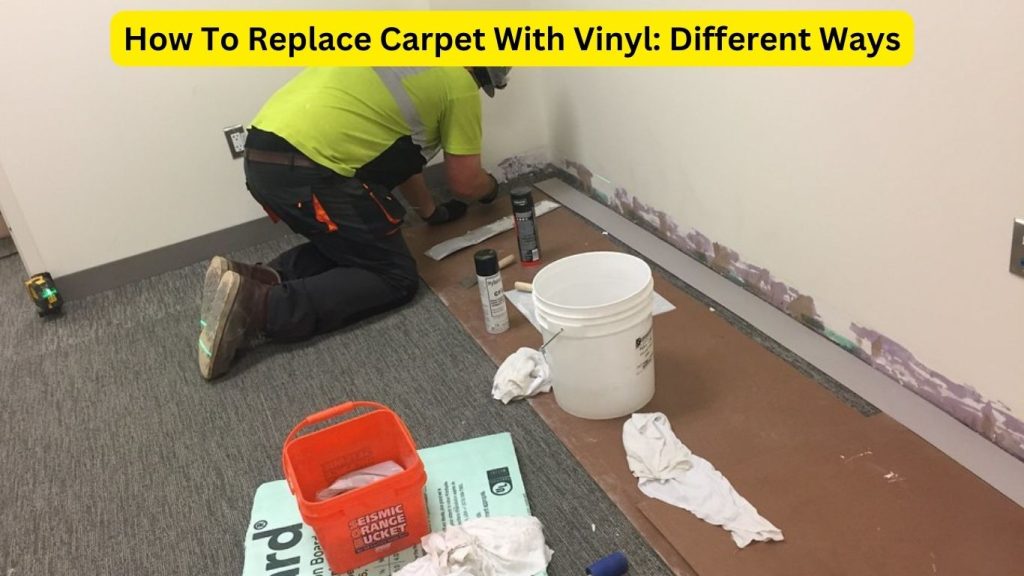Replacing carpet with vinyl is a popular home improvement project that can transform the look and feel of your space. Vinyl flooring offers numerous advantages, such as durability, easy maintenance, and a wide range of design options.

Whether you’re tired of your old carpet or simply want to upgrade your flooring, this guide will provide you with the essential steps to successfully replace your carpet with vinyl. From preparing the room and removing the existing carpet to installing the vinyl planks or sheets, we’ll cover each stage of the process.
By following these instructions, you’ll be well on your way to achieving a stylish and long-lasting vinyl floor that enhances the beauty of your home.
Table of Contents
Can You Replace Carpet With Vinyl?
Yes, it is absolutely possible to replace the carpet with vinyl. Vinyl flooring is a versatile and popular option for homeowners looking to update their floors.
Replacing carpets with vinyl offers numerous benefits such as durability, easy maintenance, and a wide range of design choices.
To replace the carpet with vinyl, you will need to follow a series of steps including preparing the room, removing the existing carpet, and installing the vinyl flooring. With careful planning and attention to detail, you can successfully complete this project and enjoy the advantages of vinyl flooring.
It is recommended to consult installation guides or seek professional assistance for a smooth and successful transition.
How Much Does It Cost To Remove Carpet And Replace With Vinyl?
The cost of removing the carpet and replacing it with vinyl can vary depending on several factors. These factors include the size of the area to be covered, the quality and type of vinyl flooring chosen, the cost of labor in your location, and any additional materials or services required for the installation.
On average, you can expect to spend anywhere from $2 to $7 per square foot for materials and installation combined. However, it’s important to note that this is just an estimate, and prices can vary significantly.
To get a more accurate cost estimate, it’s recommended to consult with local contractors or flooring specialists who can provide quotes based on your specific project requirements.
How To Replace Carpet With Vinyl: Different Ways
Replacing carpet with vinyl can be done in several ways, depending on the type of vinyl flooring you choose. Here are two common methods: using vinyl planks and using vinyl sheets. Here’s a step-by-step guide for each method:
Method 1: Replacing Carpet with Vinyl Planks
1: Prepare the room
- Clear the room of furniture, fixtures, and any other items.
- Remove the baseboards or shoe molding along the perimeter of the room.
2: Remove the existing carpet
- Start by cutting the carpet into manageable sections using a utility knife.
- Roll up the sections of the carpet and remove them from the room.
- If there is an underlying carpet pad, remove it as well.
3: Prepare the subfloor
- Remove any remaining carpet tack strips or adhesive residue.
- Repair any damaged areas on the subfloor and ensure it is clean and smooth.
4: Measure and cut the vinyl planks
- Measure the dimensions of the room to determine how many vinyl planks you will need.
- Using a utility knife or a vinyl cutter, cut the planks to fit the room, leaving a small gap around the edges for expansion.
5: Install the vinyl planks
- Start in one corner of the room and lay the first vinyl plank, ensuring it is properly aligned.
- Continue laying the planks, interlocking them or adhering them according to the manufacturer’s instructions.
- Trim the planks as needed to fit around obstacles like doorways or corners.
6: Install the baseboards or shoe molding
- Once the vinyl planks are installed, reinstall the baseboards or shoe molding to cover the expansion gap.
Method 2: Replacing Carpet with Vinyl Sheets
1: Prepare the room
- Clear the room of furniture, fixtures, and any other items.
- Remove the baseboards or shoe molding along the perimeter of the room.
2: Remove the existing carpet
- Cut the carpet into manageable sections and remove them from the room.
- Remove the underlying carpet pad if present.
3: Prepare the subfloor
- Remove any remaining carpet tack strips or adhesive residue.
- Ensure the subfloor is clean, smooth, and free of any debris.
4: Measure and cut the vinyl sheets
- Measure the dimensions of the room and add a few inches for overage.
- Using a utility knife or vinyl cutter, cut the vinyl sheets to fit the room.
5: Install the vinyl sheets
- Start in one corner of the room and roll out the first vinyl sheet.
- Smooth out any wrinkles or bubbles using a flooring roller.
- Continue installing the remaining sheets, ensuring they are properly aligned and secured.
6: Trim and finish the edges
- Trim any excess vinyl along the edges using a utility knife or vinyl trimmer.
- Install new baseboards or shoe molding to cover the edges and give a finished look.
Remember to follow the specific manufacturer’s instructions for your chosen vinyl flooring product, as installation methods may vary. Additionally, if you’re unsure about any step or lack experience, it’s advisable to consult a professional installer for assistance.
Read Next:
Final Words
Replacing carpet with vinyl is a rewarding project that can give your space a fresh and modern look.
By following the steps outlined in this guide, you can successfully complete the process and enjoy the benefits of vinyl flooring.
Remember to thoroughly prepare the room, remove the existing carpet, and properly install the vinyl planks or sheets. Take advantage of the durability and easy maintenance of vinyl flooring, and explore the wide range of design options available to suit your style and preferences.
With careful planning and attention to detail, you’ll be able to transform your space into a beautiful and functional area with a brand-new vinyl floor.
